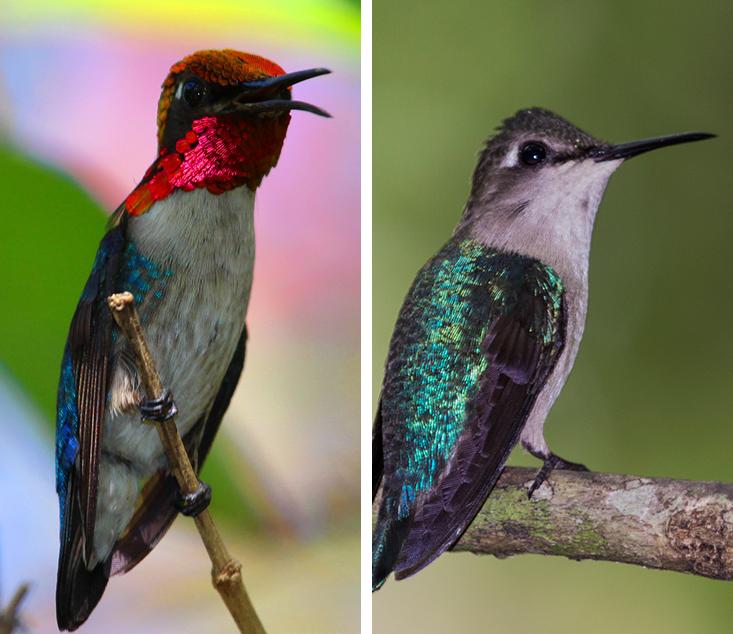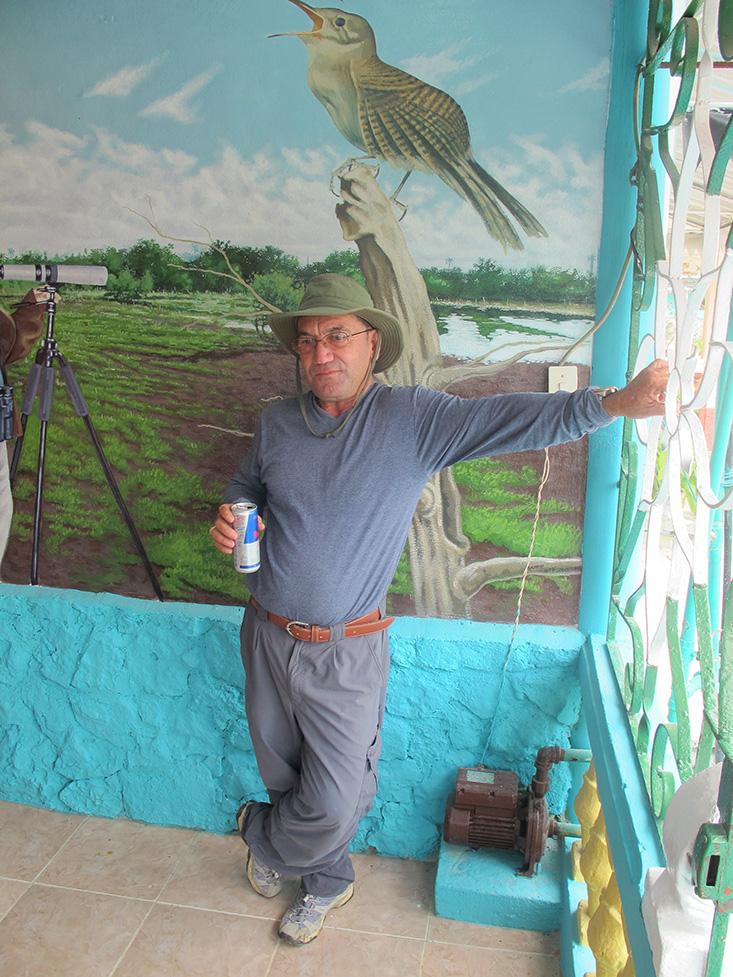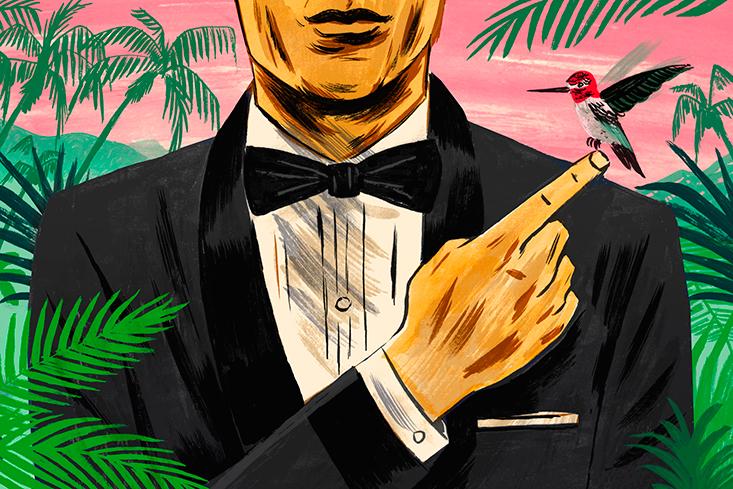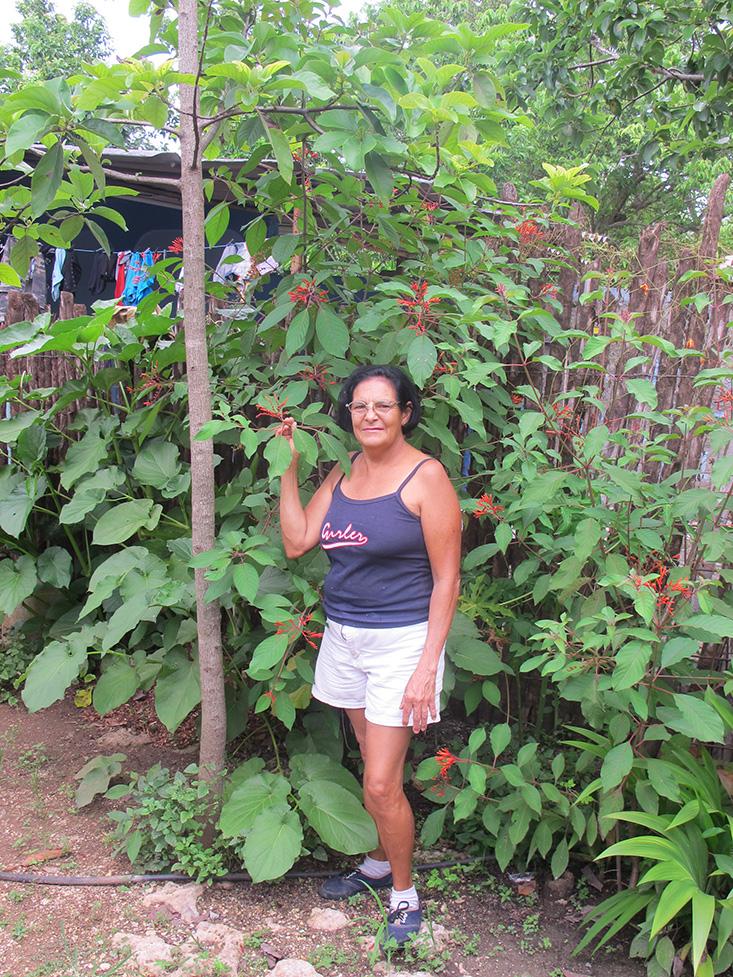I go to the country to watch
the zunzuncito climbing
through the air, and air
the misfortunes of yesterday;
so much flying and returning
through the delirious green,
free, trembling for a moment,
on the tip of a reed.
—Blas de Otero “El Zunzuncito” (1966)
Translated from the original Spanish by Pedro Gutiérrez Revuelta
To find the Cuban bee hummingbird—the smallest avian species in existence, the one whose iridescent plumage, in Key lime green, lipstick red, and sapphire blue, matches the palettes of the classic cars along Havana’s Malecón—it’s best to track down famed bird guide El Chino Zapata.
So in late May, I arranged for a fixer named Domingo to drop a peso-stuffed envelope at a Havana hotel (my credit and debit cards didn’t work on the island) and set off from Havana to the Bay of Pigs, where El Chino dwells.
This is what you do to get there: hail a cab in Old Havana with its crumbling Crayola vibrancy—paint sloughing off stucco, pigmentation fading under the onslaught of a relentless sun. Beauty in dereliction, full stop. Zoom out of the city past red dirt béisbol fields, rev along the Autopista Nacional past fincas and by the ever-intriguing Boca Laguna del Tesoro. Take in the strange olfactory combination of sugar cane and manure. A couple of hours later, when you arrive at the Zapata Swamp pueblito called Batey Caleton—spangled with propaganda posters—have your cab driver slow up. Roll down your window, and per the bird guide’s emailed instructions, ask for “El Chino.”
“¿Cuál Chino?” will be the response from the man washing his car in his driveway.
“El Chino Zapata,” you will say.
That will elicit the following palm-to-forehead-smacking epiphany: “Oh, doy—go straight and make a left.”
El Chino Zapata (aka Orestes Martínez García) has been chronicling Cuba’s feathered treasures, including the zunzuncito, as the pipsqueak bird is known locally, for the better part of the last 50 years in the Zapata Swamp. But the 57-year-old, who’s missing his left index finger (crocodile incident) and at any moment wears two pairs of binoculars over his camo clothing, is bracing himself for an uptick in tourists seeking this thimble-sized creature.

Which is a worry. The last 100 years and change have been rough on the zunzuncito, whose population has declined enough to place it on the International Union for the Conservation of Nature and Natural Resources (IUCN) Red List as a near-threatened species. The main shift started when deforestation greenlit agricultural expansion into open areas and sugar cane plantations sprouted up, says Nils Navarro, author of the recently published Endemic Birds of Cuba: A Comprehensive Field Guide. In addition to sugar, the growth of the cacao, coffee, and tobacco industries—along with mining in the Sierra Maestra mountains on the eastern part of the island—pushed zunzuncito numbers down. The bird is said to have been eliminated from Isla de la Juventud off Cuba’s south coast and exists mainly in the outskirts of Havana, the Guanahacabibes Peninsula, the Zapata Swamp, and the coast near Guantánamo. There are no precise population counts, but a 2007 study suggests its population has declined 20 percent in the last 40 years.1
Now the opening of Cuban borders for American travelers will boost both the development that is threatening the zunzuncito’s habitat and the numbers of visitors coming to catch a glimpse of it. El Chino, who has historically hosted 50 Americans annually seeking the bird, is on track to at least double that this year. The Nature Conservancy, an American nonprofit, is developing a “Conservation and Development Blueprint” to make for sustainable growth amid the expected flood of American tourists, as expected. But in my search for that little airborne splash of color, I found something less expected: Cuban citizens are themselves acting as stewards of the island’s wildlife, all in the interests of capital.
As I pull up to El Chino’s lair, a modest stucco bi-level painted in orange, aquamarine, and pink, I find myself channeling both ornithologist and MI6 agent. James Bond, the real-life ornithologist whose name came to inspire the Ian Fleming character (Fleming was an avid birder), observed the Cuban bee hummingbird during the time he spent in Cuba between 1915 and 1927 searching for new bird species. He chronicled his findings in his 1936 book, Birds of the West Indies. In fact in the 007 flick “Die Another Day,” Pierce Brosnan browses this seminal work during a scene in Havana and first introduces himself to Jinx (Halle Berry) as an ornithologist.
El Chino wears high-water galoshes and has climbing on his back his two sons, 2 and 10 years old, whom his 27-year-old daughter wrests free so El Chino can use his computer (his wife lives in Spain). He often conducts his expeditions with his brother Ángel; crouching in the forest, they’re all paunches and haunches in a mass of birding gear. El Chino (who acquired his moniker as a child) speaks an authentically Cuban Spanish; his R’s become L’s, such that “mejor” changes to “mejol,” “amor” “amol.” It would also be a revelation to him that the letter S exists at the end of many words.

I hop in the passenger seat of his rented white Geely Emgrand hatchback to head into the swamp in search of the famed zunzuncito. As he drives, El Chino speaks feverishly about the vibrancy of the bird. In Birds of the West Indies, Bond described it this way: “Male has the pileum and throat fiery red, the iridescent gorget with elongated lateral plumes; rest of upperparts bluish; rest of underparts mostly greyish white. The female is green above, whitish below, with white tips to outer tail feathers.” Bond was similarly transfixed by its teensy size: “The male is the smallest of birds; the female but slightly larger. More apt to be mistaken for a bee than a bird.” The flashing speck weighs just 0.06 ounces and is a Lilliputian 2 inches from tail to beak. The appearance of dwarf species is a phenomenon typical of small islands, and Cuba features many such creatures—the Monte Iberia eleuth (the smallest frog in the Northern Hemisphere), the tiny scorpion Microtityius fundorai, and the Cuban funnel-eared bat (weighing all of 3 grams). The isolation of island life and the competition between closely related species without room for expansion has applied evolutionary pressure on these species to be so small.
El Chino knows where the zunzuncito’s little nests are, and though feeding time is more a late-morning activity for mothers providing for their chicks, he’s bullish on our ability to catch some action around 2 p.m. as we arrive. He lets the car door softly clunk shut and marches into a dense patch of woods teeming with mosquitoes.
I too have color-lust, an urge to dazzle my eyes with this pint-sized chromatic spectacle.
He has a bird call machine to attract the species. That’s not to say El Chino needs it; he can through pursed lips mimic the susurrant sound the hummingbird emits from its wings, that thrum as it beats the air (indeed, the name zunzuncito, is an onomatopoeic rendering of its bumbling buzz). To make the hissed piss-like zzz, El Chino plants his tongue on the roof of his mouth and pushes air through. Of course the bird’s trill itself adds another element—a dog toy chirp, which Bond calls “a prolonged squeaking.” But El Chino has no luck this way, so he goes for his machine. A couple of tries with it, and still no dice. He’s frustrated and doesn’t want to have his Chino card taken from him in front of a visitor.
We pack up semi-demoralized and begin to drive toward another location, passing propaganda billboards that read “Aquí se libró un combate por la victoria” (Here a battle was fought for victory) and “Hasta aquí llegaron los mercenarios” (Up to here the mercenaries arrived). The Bay of Pigs Invasion occurred right here at La Bahía de Cochinos itself in 1961 when El Chino was 4 years old. Today the Zapata Swamp is this dankly peaceful, foliose preserve where El Chino lives his bird-obsessed life unscathed, and the contest of the day is to find a particular iridescent bird. My swampland guide insists he won’t be defeated. I too have color-lust, an urge to dazzle my eyes with this pint-sized chromatic spectacle that’s long been entrancing the island.
In 1844, Juan Cristóbal Gundlach discovered the zunzuncito and dedicated it to Helena, the wife of his friend Charles Booth. In Las aves de la isla de Cuba (1850), Juan Lembeye tackles Gundlach’s findings and veers toward the histrionic in his description of the newly identified bird, which he places atop the pantheon of Cuban avian life:
Until now, the beauty of the Cuban emerald and the [ruby-throated] hummingbird knew no rival in ornithology. To contemplate these diminutive beings as brilliant as the most refulgent star in our constellations, rapid in their movements like a fleeting breath crossing the firmament, to see them, I repeat, so nice and gracious, it would barely be possible to conceive an ensemble of greater beauty. In the varnish of their iridescent throats, all the appeal of nature seemed to have been exhausted; but just when we believed we found in them the most beautiful type of Cuban being, there appears in the middle of our perpetual garden this new species, manifesting to us with its diminutive proportions and peerless livery, that there always exists one more beyond in the marvelous works of creation.
The vibrancy Lembeye praises belongs mostly to the males. Part of the zunzuncito’s survival strategy is sexual dimorphism, with flamboyantly colorful males and duller females. The male attracts a mate with his fiery colors, his throat and rostrum the red of a Tropicana Club burlesque dancer’s dress. That performative essence may or may not have given the bird one of its local names, trovador (troubadour). James Bond’s list of local names also includes zumbete (buzzer) and pájaro mosca (fly bird). Having won his sweetheart, the male makes himself scarce during the incubation period, because his radiance could signal to predators where the nests are.
As such, after mating, the more tepid bluish-green-gold female zunzuncito—nourished with sarsaparilla, creeping lily turf, and orchids—spends 10 days using wool from a ceiba tree or the twisted airplant (el curujey) to build a comfy home in calabash trees, cashew trees, gregorywoods, and Santa Marías. Her feathers blend in with her frondiferous surroundings and form a disguise. When born, the chicks have no feathers and are a dark red, but they soon attain a gold iridescence and develop velvety feathers that are dull with hints of Prussian blue. The little pichones leave after 18 days. Mating season, after which the male sheds his most impressive colors, ends in June, which is near on the calendar. I feel the press of time. I want to see the zunzuncito’s “peerless livery”; I want to see it now.
Their curving, thin wings beat so fast they create a flipbook illusion, simultaneously up, down, and in the middle of their thorax in an instant.
El Chino and I drive up to our second location behind the settlement of Batey Caleton. A crab scuttles past as El Chino gets out of his Geely, then a large brilliant bird careens by—red, white, and blue like the Cuban flag. It’s the famed Cuban trogon (el tocoloro), and El Chino shines his green pointer on a distant tree to get the bird to take off in swooping flight.
El Chino braces himself and takes in a sense of the forest the way an aromachologist might a new eau du toilette. He uses his machine to make the zunzuncito thrum and call, then waits patiently. Yellow butterflies flutter past. El Chino emits that zzz from his lips. Not 30 seconds later, a bluish blip appears in our vision and lands on the branch of a gumbo-limbo 10 yards in front of us. It’s a female zunzuncito. El Chino and I play an impromptu game of freeze tag—not wanting to disturb the bird. She rests 5 seconds. I hold my breath. Ten seconds. I refrain from wiping away the sweat beading on my brow. Fifteen seconds. Gone—she’s shot off faster than the mind can process, like an Aerogaviota prop puddle-jumping from Havana to Nassau.
My joy is tinged with dismay. Now that I’ve had a taste of this wonder—catching in its feathers the sunlight as it poured through the boscage—I want more. Naturally, I also want to see the male—el macho—whose colors pop more brilliantly. I am slightly relieved but also feel short-changed. One zunzuncito was a tease—whetting my appetite, not sating it. But the alimentation period for mothers feeding chicks has finished for the day, and it will be difficult to catch another glimpse of the bird in the forest. We decamp to El Chino’s house, where I salute him, thank him for his help, and call a cab to bring me back to Havana.

My driver, of course, introduces himself as Fidel: “Fidel Montes de Oca, no Castro.” By way of small talk on the road, I mention that I managed to find a zunzuncito behind Batey Caleton, and he perks up. He knows a woman, by the bye, whose house in nearby Palpite has become a regular feeding point for the birds. I’ve seen one bird, and I consider myself somewhat lucky. My trip was not a total waste. Do I push my luck? I half expect to walk in to see more birds only to return and find my luggage kindly removed from the trunk of Fidel’s teal ’53 Ford, never to be found. But the truth is I want to find more zunzuncitos, to see the evanescent starburst again. So I throw caution to the wind and say what the heck.
The possibility of seeing many zunzuncitos in a day is boosted by the sustainability programs Cuba has put in place: In 1994, Fidel and Raul Castro helped to create the Ministry of Science, Technology and Environment, and Cuba since has specified 211 protected areas that cover about 20 percent of the country. Travel restrictions have helped too: Raimundo Espinoza, who heads up Cuba initiatives for The Nature Conservancy, describes Cuba as a kind of “accidental Eden.” It’s the most bio-diverse country in the region.
But the zunzuncito needs some extra attention. In the Zapata Swamp, Ernesto Reyes Mouriño, a wildlife photographer and conservationist, has an initiative in the community of Los Hondones with the goal of empowering local residents to plant flora attractive to birds. For starters, his team and he are working with three local houses, plus four other houses owned by him and the other biologists. His efforts are mirrored by other local conservationists, who have encouraged habitat preservation through resident education. In this mission, perhaps nothing is quite as helpful as the casa particular, Cuba’s answer to Airbnb.
Cuban families have been able to rent out their properties for profit since 1997, but the casa particular took off in 2011 when Cuban law allowed for the promotion of private businesses. There are thousands of listings for casas particulares across the island, 2,000 on the Airbnb website alone. In the past two to three years, these rural community houses have begun to build natural fencing with saccharine shrubbery and trees attractive to zunzuncitos, according to The Nature Conservancy’s Espinoza. Individual households that rent to tourists are maintaining the sugary plants the sweet-toothed zunzuncito craves (its genus, Mellisuga, is a combination of the Latin words for honey and suck), because owner-operators know the tourists like the bird. At least in this small way, protecting Cuba’s hidden treasures, like the zunzuncito, is being made easier by the harmony between tourist development and cultivation assistance of natural habitats. Suddenly the expected tripling of American visitors to the island, to 1.5 million annually, takes on a different light.
In Palpite there are six houses with the Hamelia patens tree (known as firebush or hummingbird bush, and locally called ponasi) that zunzuncitos consider particularly yummy. As Fidel and I get to the house he has in mind, a casa particular, I notice hibiscus bushes at the front of the property—a natural demarcation. There we meet Juana Matos Gómez, 61, who pronounces we’ve arrived at “La Casa de zunzuncito.” She lives there with her husband, Bernabé Hernández Ulloa. Flying around her front yard are a couple of Cuban emeralds (the zunzuns, not to be confused with their smaller, diminutively-named cousin). My heart drops a little. Our kind hosts have confused the bird, I think.

But then she whisks me around back, a place with a guesthouse shed and a firebush that bursts with tubular flowers throughout the year. This tree has been there for years, and zunzuncitos have been visiting for the last three. As we’re looking at the tree, Matos Gómez suddenly goes nuts. “Ooo, mira-mira-mira,” (Ooo, look-look-look), “ooo, mira-mira.” Up close, a blue male appears, hardly larger than the pistil on the tree’s flowers, floating with rapid wing movements as he feeds. He has a mother-of-pearl belly and a cobalt blue back.
Every freaking second, Matos Gómez is like “ooo, mira-mira-mira,” pause, “ooo, mira-mira.” The birds are there in abundance—some fledglings, even, who have recently left the nest and flaunt their metallic varnish. Their curving, thin wings beat so fast (80 times a second, 200 when mating), they create a flipbook illusion, simultaneously up, down, and in the middle of their thorax in an instant, with negative space splashed throughout. The eyes and mind can’t process it; the effect is like a seizure-inducing strobe light.
The male zunzuncito sips from the flowers of the firebush in a completely horizontal fashion, then goes from lento to violento, zipping off.
… ooo, mira-mira-mira …
The bird is otherworldly, its feathers appearing phosphorescent. Its shimmer is enhanced by a phenomenon known as structural coloration. If you were to shine a flashlight on the backside of a zunzuncito’s wings, they’d actually be gray. The iridescence is caused by the microscopic structures of the bird’s feathers; light hitting the front of the feather gets refracted through the layers as if by a prism. The flitting, fleeting birds keep shooting in for a sugar fix at the firebush—mostly one at a time—before launching off out of sight or to the limb of another tree nearby. The humming zzz is pervasive, like static from a transistor radio. More birds keep appearing at the firebush—an invasion of itsy-bitsy speedsters drinking nectar. A male perches high on the antenna atop the house and then flaunts his wing speed while floating almost stationary in the 5 o’clock sky before kamikaze-ing down for more sugar. Matos Gómez is delighted. In little visual bites, intoxicating splashes of color, I’m getting the fix I need.
In Matos Gómez’s back yard I’ve found a capitalistic citizen environmentalism serving an American tourist by protecting what he came to see, satisfying every zunzuncito-wish I ever had. When I get back to New York, El Chino will tell me he has a new project: planting seeds in the gardens at surrounding casas particulares to grow tasty and brightly-colored attractions for the zunzuncito. In Palpite, feeding at the vermillion firebush, the darting birds, in their kaleidoscopic sheen, seem to be expecting more guests, the ones with direct commercial flights from New York to Havana. They fly triumphantly as if doused with some galactic mercury, effulgent in the sunlight.

Ross Kenneth Urken is a writer living in Manhattan. Read more of his work here.
Reference
1. González, H., et al. Distribution, diversity and abundance of birds’ communities in different type of vegetation of the Park Alejandro of Humboldt and the Ecological Reservation Baitiquirí. Final Report of Project: Eastern Cuba: Saving a Unique Caribbean Wilderness (2007).






























